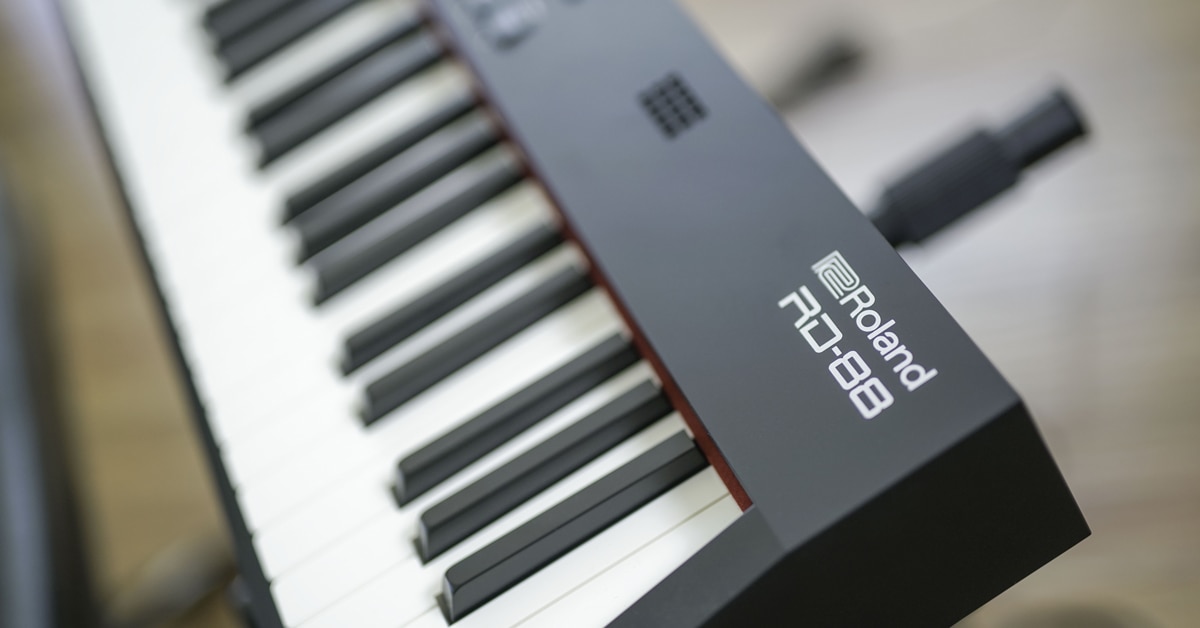Digital pianos have made huge advances in recent years making their high quality sound and relatively low cost a great alternative to acoustic pianos for many players. Due to the range of functions and features they offer, finding the best digital piano for your purposes can initially seem a little daunting.
Read on to gain a basic understanding of their various features that will help you confidently choose the best digital piano for your needs.
Table of Contents
Undecided About a Digital Piano?
How to Hone in on the Right Model
Digital Piano features
Keyboard Action and Touch Response
Digital Piano Sound Quality
Polyphony
Number of Sounds/Tones
Learning Tools
Amplification and Speakers
Digital Pianos for Home Use
Digital Pianos for Stage and Studio
Digital Piano Accessories
Amps and Cables
Piano Benches
Digital Piano Covers, Gig Bags and Cases
Digital Piano Stands
Need More Help?
Digital Piano Glossary
Undecided About a Digital Piano?
If you’re not sold on purchasing a digital piano versus a traditional acoustic piano, here are some advantages to consider:
Convenience/portability - Digital pianos are much lighter and usually more compact than acoustic pianos. Even console models that have a cabinet resembling a traditional piano generally weigh far less than their acoustic counterparts. Most models can be easily broken down for storage while digital pianos designed for stage performance will easily fit in your vehicle when you hit the road.
Cost - Digital pianos generally cost far less than their acoustic counterparts. Maintenance beyond dusting is pretty much a non-issue with digital pianos whereas acoustic pianos require tuning from time to time—a costly service.
Volume/Versatility - A traditional piano generates a certain volume range depending on how hard you strike its keys. Digital piano volume is easily controlled over a wide range and silent practice is possible using headphones on most models—a blessing for the rest of your household. With the extensive sound sets built into digital pianos, you can easily add drums and percussion, woodwinds, brass, and many other sounds to your performance.
Recording capability - Most digital pianos allow you to record your performance, which can be an advantage when you’re learning to play and want to review how you’re progressing. Recording and sequencing capabilities are also important if you plan to create your own songs.
Connectivity - Most digital pianos have MIDI capability allowing you to connect to computers and recording equipment. Many have a USB port making connections with all kinds of audio gear simple. Some models accept flash memory cards so you can transfer music to other devices and computers.
Teaching/learning tools - Electronic pianos designed for beginners and the school market often include built-in lessons, exercises, note/chord displays, and metronomes as well as access to online resources. Some have dual headphone jacks allowing students and teachers to work together silently. Those with split-keyboard functions allow teacher and student to play the same parts in the same octaves.
How to Hone in on the Right Model
Here are the key considerations:
Your experience/skill level - If you’re an absolute beginner, a low-cost model with some built-in learning tools may well suffice until you’re ready to step up to a more advanced digital piano. On the other hand, if you’re an intermediate or advanced pianist, you’ll likely want to be more selective about touch response and velocity sensitivity discussed under Digital Piano Features below.
Check the dimensions - Make sure the piano will fit in the space(s) you have in mind. If you’re purchasing the piano for a child, check if the keyboard height is appropriate. (Adjustable stands, or in a pinch a phone book under the pedal(s), can help solve any mismatches.)
Portability/storability - If you expect to store the digital piano or travel with it, check the weight and the ease with which it can be broken down.
Digital Piano Features
Before we delve into the various types of digital pianos that are available, there are a couple of critical areas to cover: their touch and sound.
Keyboard Action and Touch Response
One of the main differences between pianos and electronic keyboards is the feel of the keys. Piano keys have resistance resulting from their mechanical components including the wooden hammers that strike the strings inside an acoustic piano. If you’re transitioning from a traditional acoustic piano, the degree to which a digital piano mimics an acoustic piano’s action makes a big difference in its playability.
Weighted and semi-weighted actions have a response more like that of a traditional piano. Hammer action adds actual mechanical hammers to enhance this response even more. A small hammer embedded in the key gives you a subtle “thunk” when it’s played simulating the response of an acoustic piano’s keybed.
The best keybeds are sometimes identified as being “fully weighted.” They also will have graduated weighting so that lower octave keys have greater weight imitating the heavier hammers and strings found in acoustic pianos. This is usually referred to as “graded hammer action.”
Another important factor is touch or velocity-sensitivity. The best digital pianos are capable of sensing subtle differences in velocity that determine the attack and volume of each note. Low-cost digital pianos often have volume level switches, which are a giveaway that they don’t have real velocity-sensitivity. (Better quality digital pianos also have volume controls in the form of a knob or slider that adjusts the overall output of the piano. But momentary volume on models with velocity-sensitivity is determined by how hard you strike each key.)
Digital Piano Sound Quality
The sound of an acoustic piano depends on the quality of its components, while digital pianos primarily depend on the samples used to create their sounds. The digital technology used to capture and reproduce the samples of various pianos and other instruments plays a role in how well the digital piano will emulate those instruments. Generally, higher end digital pianos contain more digital memory allowing them to reproduce high-resolution sounds with greater realism that closely emulates the sound of acoustic instruments.
In judging sound quality, pay special attention to the sustain and decay of the notes as well as the overall realism of the sounds. Another factor that affects the overall sound is the quality of the amplifiers and speakers used in digital pianos.
Polyphony
Polyphone refers to the number of individual notes or tones the piano can produce at once. At a bare minimum, you should have 32-note polyphony while 64-note polyphony is more adequate for creating complex sounds. The highest quality electronic pianos deliver 128-note or 264-note polyphony.
Number of Sounds/Tones
While it may seem like a big deal that today’s pianos often include hundreds of sound samples from instruments like accordions, organs, synthesizers, flutes and so on, once the novelty wears off, you’ll likely find yourself sticking to the more basic piano sounds. Having hundreds of tones and effects to choose from can turn into a distraction. That said, some effects such as judiciously used reverb can help enhance the sound. The ability to play with backing instrumental tracks can also increase the fun factor.
Learning Tools
Many digital pianos come with helpful learning tools including lessons that can take you from a raw beginner to a more accomplished player. Displays that show the chords being played as well as various lighting schemes that help beginners pick out melodies and chords can be helpful. A built-in metronome is useful to improve your rhythmic ability. Some models allow the keyboard to be split into sections so that a student and teacher can share one keyboard while playing in the same octaves.
Amplification and Speakers
Generally speaking, if you are looking for a piano for home use, you will want to make sure your instrument has a built-in amp and speakers that produce a pleasing sound with adequate volume. If you are looking for a digital piano for live performance or recording in studio settings, be sure it has the output options for connecting to PA systems, external amplifiers or recording consoles.
Other features to look for depending on how you plan to use the piano are a headphone jack and USB port for connection to your computer.
Digital Pianos for Home Use
Pianos intended for home use may be console pianos, or be housed in a standard electronic keyboard format—with or without stands. Digital pianos for home use include many of the same components as those designed for the studio or stage, but always have built-in speakers.
Console pianos are housed in a more traditional cabinet designed to blend in with household furnishings.
There’ is a wide spectrum of in-home models available that span a broad range of quality and prices.
The Williams Allegro 3 88-Key Digital Piano is a great example of an entry-level digital piano, with 88 hammer-action keys for a beginner-level price.
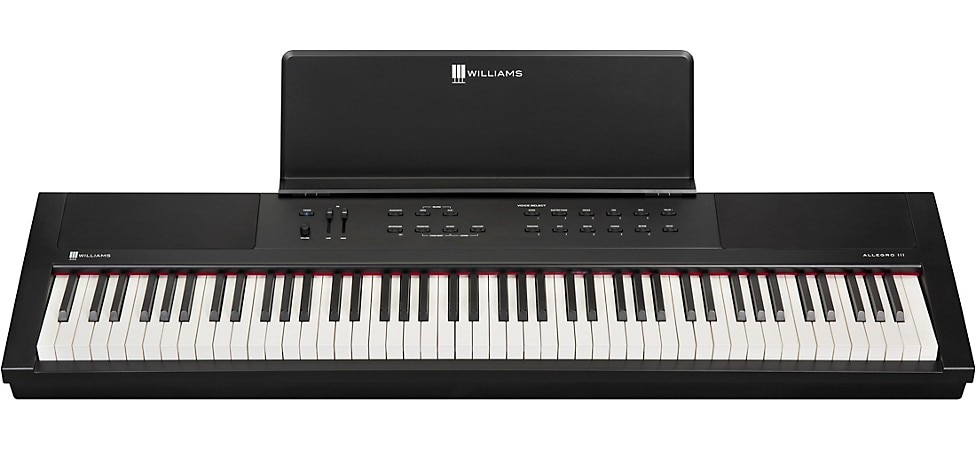
The Williams Allegro 3 Digital Piano simulates most of the feel and sound of an acoustic instrument, making it a great first piano.
The Allegro features 64-note polyphony, eight piano voices, a built-in metronome, MIDI capabilities, and more. With its basic simulation of an acoustic piano experience, and some simple digital features, Williams’ Allegro is a great choice for the new piano player.
Casio’s Privia PX360 Digital Piano is a more advanced instrument primarily designed for home use. Like the rest of the Privia line, the PX360 uses Casio’s AiR sound engine and 88 full-size, weighted scaled hammer-action keys emulate the sound and playability of an acoustic piano.

The Casio Privia PX360 Digital Piano is a good midrange choice for home use that features most of the Privia line’s advanced features for excellent sound and playability.
Textured keys help replicate the feel of an acoustic piano. The PX360 has 550 built-in tones, optional duet mode, various reverb and chorus effects, a built-in metronome, and more.
Experienced pianists and dedicated students will appreciate a console piano like the Yamaha Clavinova CLP-725 Console Digital Piano. The 88-key digital piano features a GrandTouch-S action with synthetic ebony and ivory keytops. There are 10 distinct on-board sounds including meticulously sampled Yamaha CFX and Bösendorfer Imperial pianos. Three foot pedals provide the soft, sostenuto, and sustain/damper effects of an acoustic instrument.
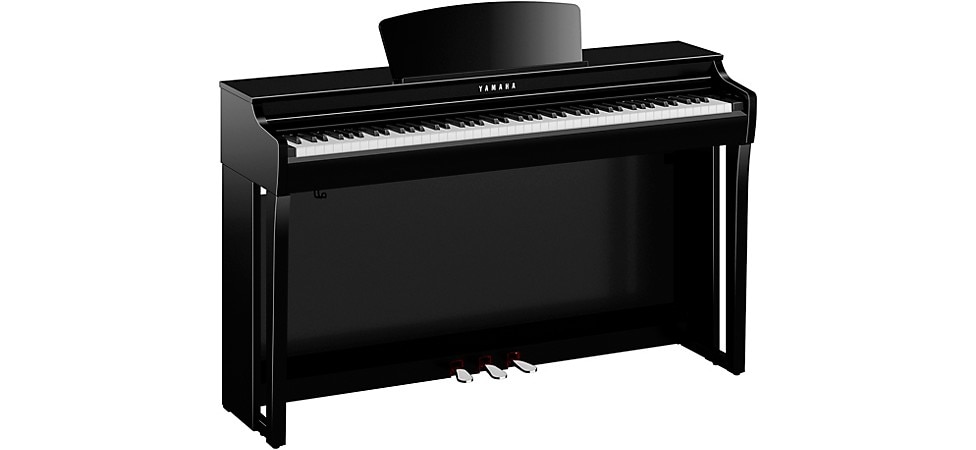
Yamaha's CLP-725 Console Digital Piano is their entry-level Clavinova, ideal for beginners or experienced players looking for a home piano. Classic looks and sounds make it a great choice.
Whatever your skill level, long-term plans, or budget, there is an in-home digital piano to match your needs. You can browse the entire Musician’s Friend selection of digital pianos designed for home use here.
Digital Pianos for Stage and Studio
Stage digital pianos are designed to be more mobile and versatile than console pianos and target musicians who regularly travel to different venues and/or studios. They do not have cumbersome cabinets, and usually have more voices, effects, and connectivity options than digital pianos intended for home use. Generally their sound engines are of a higher quality to meet the demands of the pro performer.
Like home digital pianos, however, stage pianos are available at a wide range of price points and capabilities, so that there you should be able to find a model that matches your performance needs and budget.
Korg’s SP-280 is a basic stage digital piano with a modest price tag. It features a full, hammer weighted keyboard and built-in amplification in a lightweight design for easy transportation. It comes with a black metal stand that folds and attaches easily. With line out, MIDI and headphone connectivity, it makes a good choice for performance in smaller venues and a great addition to the home studio.
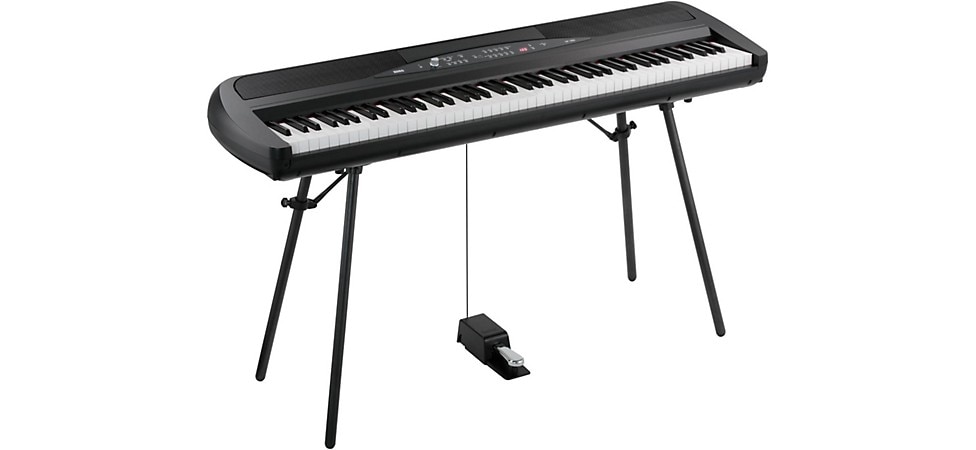
The Korg SP-280 has well-regarded sounds and is easy to transport.
A damper pedal is included, and an optional pedal unit can provide soft and sostenuto pedal effects as well. Its 30 voices are more than enough for a more traditional player and both its concert grand and vintage electric piano voices get high marks. Weighing in at just 42 lb. including the stand, it’s very portable.
Take a tour of the Korg SP-280’s impressive sounds.
A more experienced musician will appreciate the advanced capabilities of Casio’s Privia PX-5S Pro.

Casio’s Privia PX-5S Pro has excellent sound, great keyboard feel and road-friendly weight.
The PX-5S Pro is a mid-range model that travels easily thanks to its 25 lb. weight. It has a full, scaled hammer action keybed and an excellent collection of sounds including realistic grand pianos, retro electric pianos as well as very usable clavinet and harpsichord voices. 256-note polyphony handles the most complex arrangements. With four-zone MIDI control that includes four knobs and six sliders ,you can control internal sounds and external MIDI gear simultaneously. MIDI independent USB plus MIDI I/O as well as ¼” I/O and a ⅛” audio input gives you lots of connection flexibility.
Watch the Casio Privia PX-5S Pro in action.
The Privia PX-5S features 4 programmable arpeggiators that can be played simultaneously. In addition to four system-wide effects you can also apply up to four simultaneous insert effects to shape your sound for particular songs or venues.
Roland's RD-2000 is for serious musicians who need fantastic acoustic and electric piano sounds, plenty of on-board controls and truly superb playability. The 88-key graded hammer action precisely replicates the feel of an acoustic piano. With an extensive range of MIDI connections (In, Out, Through and USB) as well as XLR and !/4" outputs, the RD-2000 is ready for the road and studio.

The Roland RD-2000 is a studio-quality digital piano to meet the needs of professional performing and recording artists.
Roland's streamlined RD-88 digital piano is designed to deliver players the premium sound and feel of the RD line, but with affordability and portability in mind. Weighing in at just over 29 lbs, the RD-88 has more than 3,000 sounds and the PHA-4 keybed with Escapement and Ivory Feel offers a true piano playing experience. A full compliment of connectivity as well as deep integration with Apple's MainStage software make the RD-88 a great choice for the gigging musician.
Ruslan Sirota takes the RD-88 for a spin.
Whether you need a good digital piano that travels well or will be a key element in your home studio, there are models to suit your music and budget. Browse the entire Musician’s Friend collection of stage digital pianos here.
Digital Piano Accessories
Depending on the instrument you choose, and your intentions for it, you should also consider picking up a few optional accessories. Some of these items will be included in the package you decide on, but they are not always standard. Accessories you may need include:
- Amps and cables
- Benches
- Covers, gig bags, and cases
- Stands
Take a minute to decide what you will need before you make your final purchase, so you can be sure of getting everything at once.
Amps and Cables
If you’re shopping for a console digital piano for use at home, you will probably select an instrument with a built-in amp and speakers. If you are in the market for a stage piano, and you know you are going to need extra volume for a large venue or for playing with an ensemble where a PA isn’t available, you will probably need to consider an amp and cables.
An entry-level keyboard amp like the Roland KC-200 will provide a good sound for a smaller price tag.
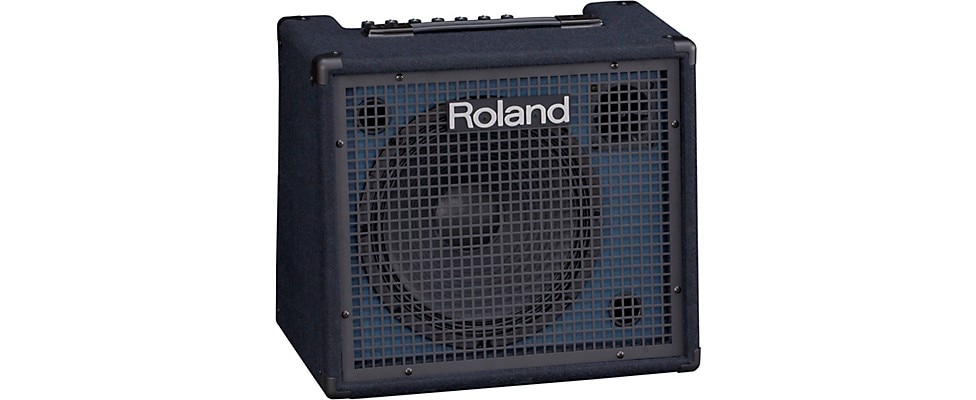
A mid-range keyboard amp, the Roland KC-200 is perfect as a monitor or an amp in smaller venues.
Roland’s KC-200 is a heavy duty little keyboard amp that actually produces a great sound for a variety of instruments. At 100W, and with a 12” woofer, this box is perfect for smaller settings, or as an on-stage monitor. The four-channel capability and multiple input options make it a great buy for the price.
Keyboard amps are available with a variety of features and at a wide range of price points. If you need something more affordable, something more powerful, or something more suitable for your home studio, browse the entire Musician’s Friend selection of keyboard amps here.
Selecting instrument cables for digital pianos pianos is pretty straightforward. Most have a basic 1/4" phone jack connector, like the Planet Waves American Stage Instrument Cable.
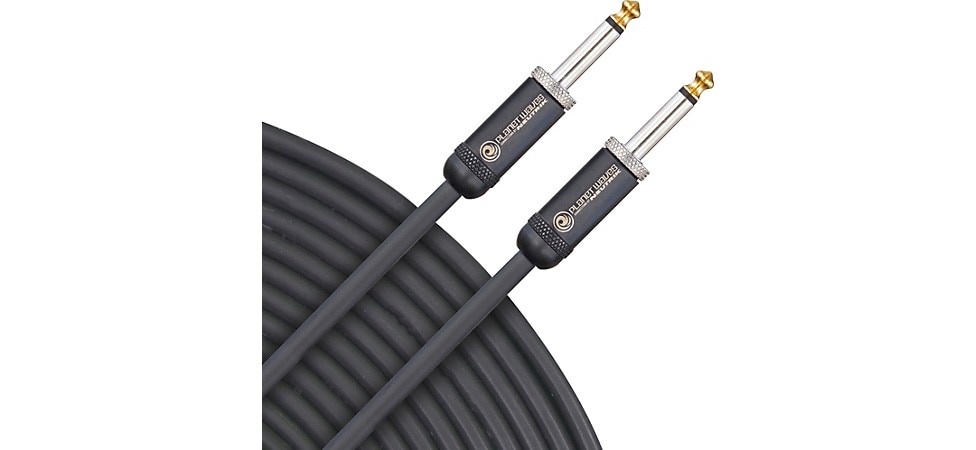
The Planet Waves American Stage Instrument Cable is 10', and uses audiophile-quality wire to deliver the most accurate sound from your piano to your amp.
There are longer and shorter 1/4" cables, XLR cables, and some specifically designed to hold up under lots of touring and travel. You can browse the entire Musician’s Friend collection of instrument cables here.
Piano benches
Some console digital pianos come with a bench that matches the instrument’s cabinet, but many digital pianos do not come with seating.
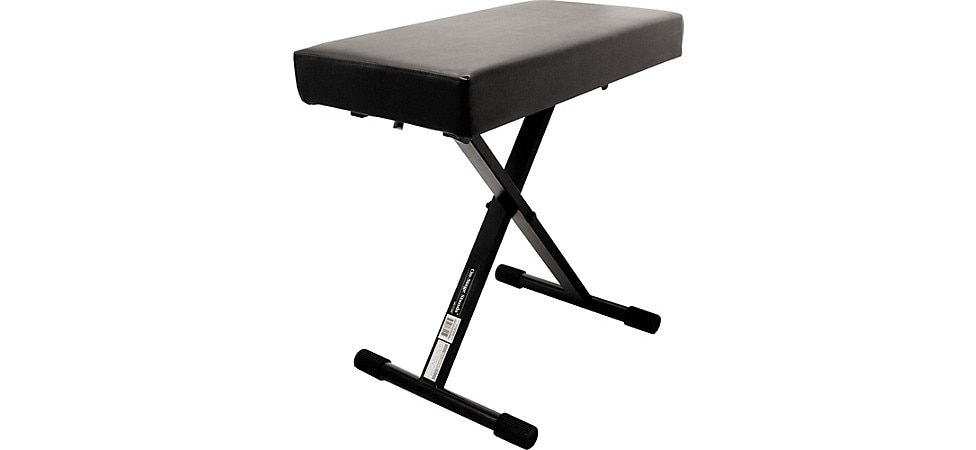
On-Stage Stands’ KT7800+ Keyboard Bench is comfortable enough for home, and sturdy enough for the road.
The On-Stage Stands KT7800+ Keyboard Bench is a great example of a basic bench at a very reasonable price. The simple folding action and spring-loaded deadbolt, combined with a sturdy build and three-inch cushion, make it a great option for travel and portability without compromising comfort and stability.
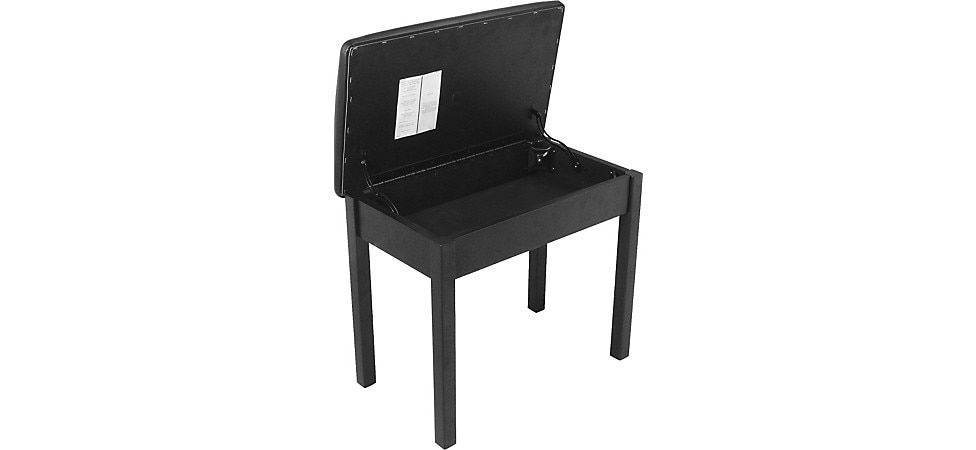
The On-Stage Stands KB8902 Flip-Top Keyboard Bench blends with any home decor and has a comfortable padded cushion.
If your digital piano will be staying at home, you may prefer the more traditional look of a four-legged, fixed-height piano bench. On-Stage Stands’ KB8902 Flip-Top Keyboard Bench is a perfect example. Simple and classic in design—right down to the flip-top for music storage—this bench still boasts stage-worthy durability.
Whether you need a bench for the road or for home, adjustable height or fixed, there are a lot of options in various price ranges and finishes. Browse the entire assortment of Musician’s Friend piano benches here.
Digital Piano Covers, Gig Bags and Cases
For the traveling musician, a case or gig bag is a top priority. If your piano will be staying at home, you may want to consider a cover. Be sure to check the dimensions to ensure you choose one that will accommodate your keyboard.
Covers simply stretch over the piano to keep it clean and protect it from spills or accidents that could introduce moisture to the electronics or cause surface damage. A gig bag is a soft case that provides some protection, and makes it easy to transport the instrument. A case is rigid and provides the greatest protection for pianos that travel.
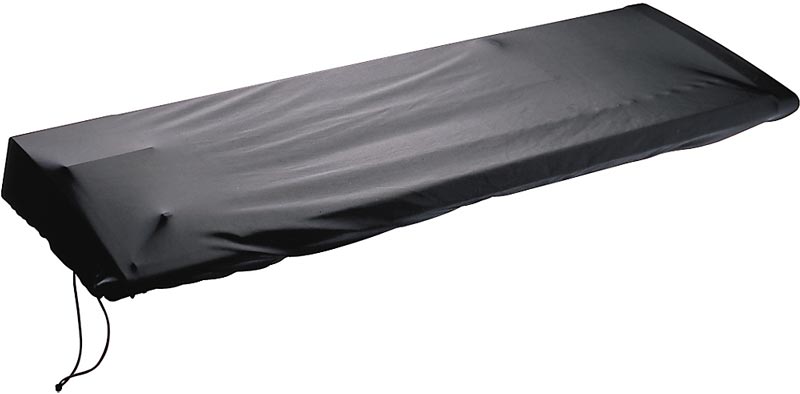
The Gator 88 Key Stretchy Keyboard Cover is great or keeping your digital piano dust-free and protected.
Gator’s 88 Key Stretchy Keyboard Cover is a simple cover at a great price. It is washable, and cinches with an adjustable shock cord—instead of elastic—to ensure a snug fit on any full-sized digital piano.
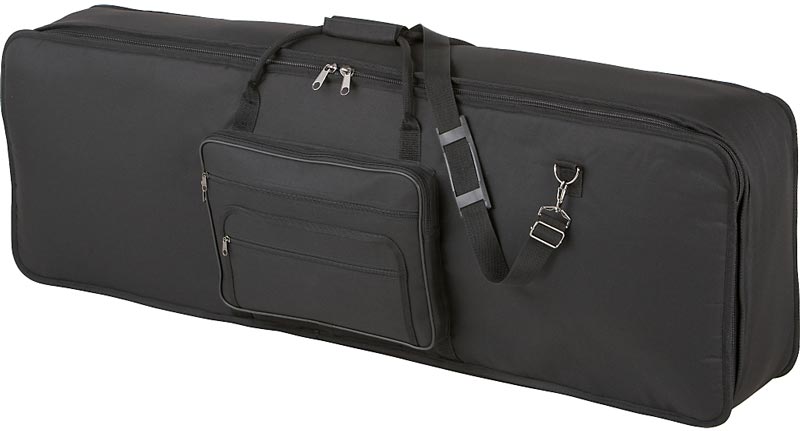
Musician’s Gear’s 76-Key Keyboard Gig Bag is a durable, trustworthy option.
The Musician's Gear 76-Key Keyboard Gig Bag has a durable nylon twill exterior and plush foam padding. Reinforced edges and handles make it perfect for home storage or light travel.
If your piano is on the road (or in the air) a lot, and you need something more heavy-duty, the Gator TSA ATA Molded Keyboard Case is a solid choice. This molded polyethylene case, with wheels and TSA latches, is airline-approved. The interior is adjustable, to offer the best protection for just about any 88-key digital piano.
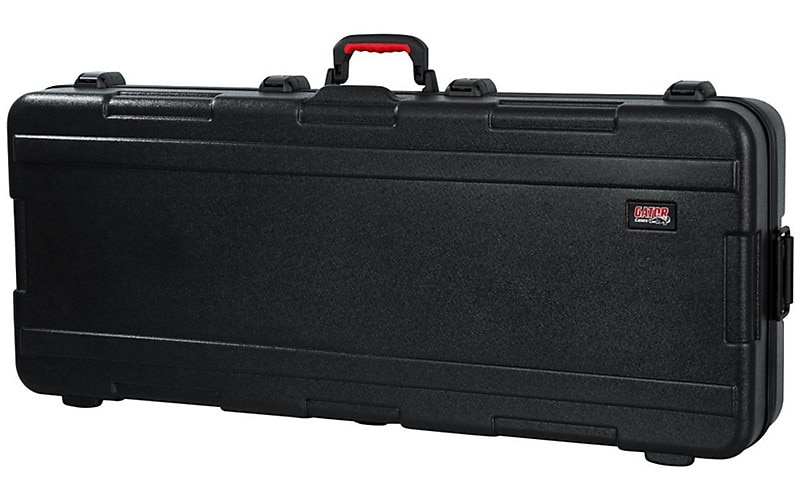
Gator's TSA ATA Molded Keyboard Case features rugged construction and TSA-approved locks.
If you just need an affordable cover to keep you console piano clean, or if you need something sturdy for travel or storage, there are lots of options. You can browse the complete Musician’s Friend selection of piano covers, gig bags, and cases here.
Digital Piano Stands
Digital piano and keyboard stands are available in a variety of styles, and with a variety of capabilities. Table and X-Style stands are two of the most popular styles. Most stands are designed for one keyboard, but some are built to hold two.
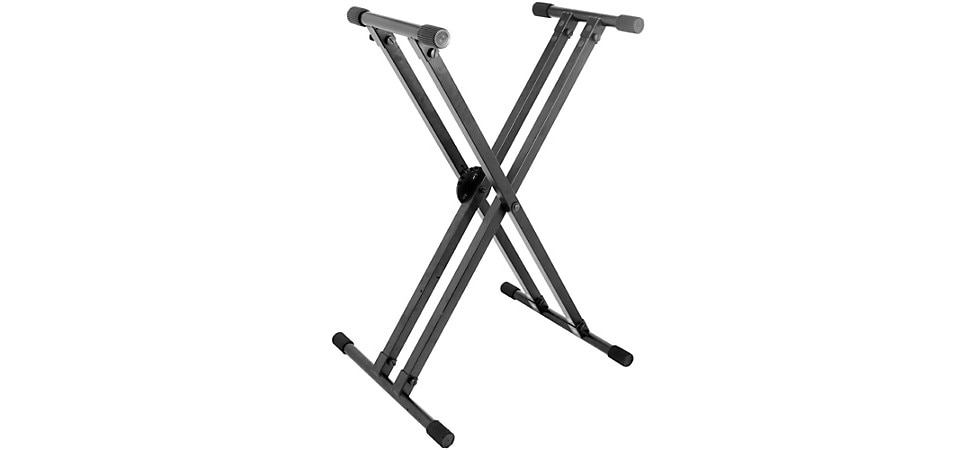
The On-Stage Stands Heavy-Duty Deluxe X ERGO-LOK Keyboard Stand is simple and sturdy.
The On-Stage Stands Heavy-Duty Deluxe X ERGO-LOK Keyboard Stand is a very popular single-piano, X-style stand for a variety of digital pianos. It folds easily for transport, but also locks quickly and supports over 300 pounds with welded construction for peace of mind.
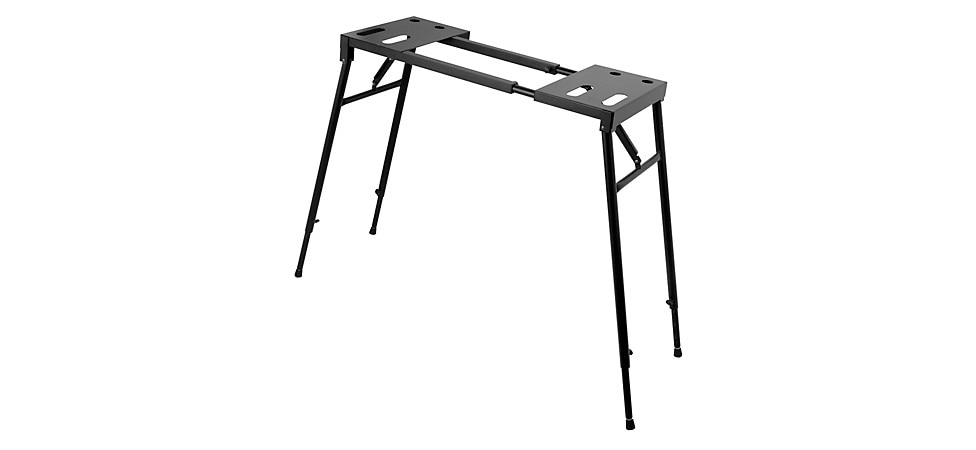
The On-Stage Stands Pro Platform Keyboard Stand combines the stability of a table stand with a folding design for travel.
Table stands are a good choice for heavier keyboards. The On-Stage Stands Pro Platform Keyboard Stand provides plenty of support with its 230 lb. capacity and has adjustable height and width.
Depending on your intended use, you may prefer an A-frame or tiered stand. You can browse the entire Musician’s Friend collection of digital piano and keyboard stands here.
Need More Help?
If you have questions about digital pianos or any of their accessories, just pick up the phone and one of our helpful associates will help you find exactly what you’re looking for.
Digital Piano Glossary
Aftertouch - A MIDI control activated by continuing to apply pressure to a key after the key has been played, and while it is being held to sustain the sound. It frequently controls effects like vibrato or volume.
Arpeggiator - A keyboard function that produces an arpeggio (a basic major chord) when a single note is played to enhance the grandeur of a performance.
Assignable - The ability to have one keyboard control affect specified parameters selected by the user.
Auto-accompaniment - A feature that plays backing performances, often made up of a number of instruments, to enhance a performance.
CompactFlash (CF) - A memory mass storage system developed by SanDisk that uses small cards to transfer data to and from compatible devices.
Damper pedal - A pedal that, when pressed, maintains a note's sustain until released. Also called a sustain pedal. The damper pedal is the right-most pedal where two or three are present. When a digital piano only has one pedal, it is usually the damper pedal.
Decay - The speed at which the sound of a note fades away after it is played
DSP - Digital signal processing. This is how most keyboards produce effects, equalization, filters, etc.
Effects - Processes that change a tone or tones, like reverb, delay, vibrato, etc.
Filter - An electronic circuit that alters a tone by removing specific frequencies.
FireWire - A high-speed data connection developed by Apple—similar to USB, but much faster.
Hammer action - A keybed feature that uses small hammers to trigger notes in order to re-create the feel of an acoustic piano.
Keybed - The keys of a digital piano and their underlying mechanisms.
Layer - A function that enhances a sound by overlapping different tones.
MIDI - Musical Instrument Digital Interface - A protocol that allows musical instruments and digital devices to communicate with each other. GM is short for General MIDI, a music industry standard since 1991 that ensures consistent performance on all GM-compatible instruments and standardized sounds and locations. GM2 is an extension of GM that requires 32-voice polyphony (instead of 24 for GM) and includes more programs.
mLAN - A network protocol designed by Yamaha that uses FireWire cable to for transmitting digital audio and MIDI data among a number of devices using a FireWire cable.
Modulation wheel (mod wheel) - A wheel-shaped controller that alters various elements of a tone.
Multitimbrality - The ability of a keyboard to play different sounds at once, i.e. flute, drums, strings, piano, etc. Multitimbrality should not be confused with polyphony, which is the number of tones.
Pitch bend wheel - A keyboard controller that may take the form of a knob, ribbon, or joystick, and that smoothly changes the pitch of the note being played
Polyphony - The number of tones a keyboard can produce at once
Rhythms - Drum beats and other percussion instruments that are programmed into a keyboard in various musical styles
Sampler - A device that records digital audio and so it can be altered and played back
SmartMedia - A Toshiba memory storage system that uses small memory cards to transfer data to and from compatible devices. Similar to CompactFlash, but SmartMedia cards are smaller.
Sostenuto pedal - A keyboard pedal that mimics the pedal of the same name found on grand pianos. It sustains only the notes that are being held down when the pedal is pressed. When three pedals are present on a piano, the sostenuto pedal is the middle one.
Split - A function that allows the keyboard to be divided into different sections, with different tones assigned to each one
Sustain - How long a note sounds after it is initially played
Touch sensitivity - The responsiveness of a keybed to player actions—like the velocity with which keys are pressed and the amount of pressure placed on the key—in order to simulate the feel of an acoustic piano.
USB - Universal Serial Bus, a common connection protocol for computers. Many keyboards provide a USB connection to transfer data to and from a computer and other digital devices.
Voices - Different instrument sounds programmed into a keyboard or digital piano
Weighted/semi-weighted - Weighted keybeds feature resistance in order to replicate the feel of an acoustic piano.





































































































































